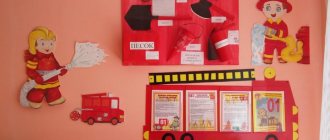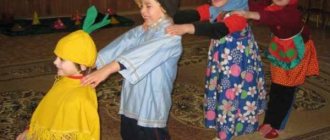Learn fire safety rules
Action plan for children of senior preschool age.
Our little fidgets are in a hurry to explore the world, not realizing the danger that it can bring. And we, adults, cannot always be there to help. That is why it is necessary to develop in children a conscious and responsible attitude towards personal safety and the safety of others. And in this sense, it is very important to introduce them to fire safety rules before school.
Every year we conduct a series of safety events in our kindergarten, the purpose of which is to develop in children the skills of careful handling of fire and an understanding of the need to comply with fire safety rules.
Tasks
- Give children initial information about the causes of a fire.
- Introduce the properties and qualities of objects in terms of their fire hazard.
- Give an idea of the work of firefighters and their professional actions.
- Teach children the rules of safe behavior in the event of a fire: be able to navigate the space of a group room, apartment, know the first actions in the event of a fire, be able to call the rescue service “01”.
- Develop a cautious attitude towards objects that are high sources of fire hazard.
- Foster respect for the firefighting profession.
- Foster a desire to provide mutual assistance and take care of your life and health.
The formation of the foundations of children’s life safety is carried out in different directions, the main ones being work with children, parents, teaching staff and staff. It is important not only to protect the child from danger, but also to prepare him to face possible difficulties, to form an understanding of the most dangerous situations, the need to take precautions, and to instill in him the skills of safe behavior in everyday life together with his parents, who act as role models for the child.
April
I. Methodological work
1. Work with children.
A. Organized educational activities:
- Reading fiction. Cognition. Safety. Communication. Reading the poem by S. Marshak “The Story of an Unknown Hero.”
- Cognition. Safety. Communication. Conversation “Why does a fire occur?”
- Cognition. Safety. Communication. Conversation “If there is a fire in the house.”
- Cognition. Work. Safety. Communication. Conversation “Firefighter is a heroic profession.”
- Cognition. Work. Communication. Excursion to the fire station. Introducing the fire truck.
- Artistic creativity. Cognition. Reading fiction. Safety. Communication. Drawing based on impressions from the work read and from the excursion. X Reading fiction. Cognition. Safety. Communication. Reading the work of S. Marshak “Cat’s House”.
- Work. Cognition. Socialization. Reading fiction. Communication. Joint activities with the teacher. Making masks for the dramatization game “Cat House”.
B. Independent activities of children:
- Physical Culture. Socialization. Health. Outdoor game “Who is faster?”
- Socialization. Cognition. Safety. Communication. Didactic game “Objects are sources of fire.”
- Socialization. Cognition. Safety. Communication. Role-playing game “We are firefighters.”
- Cognition. Socialization. Safety. Communication. Didactic game “What does a firefighter need?”
B. Cultural and leisure activities:
- An evening of entertainment. Cognition. Reading fiction. Safety. Communication. Dramatization game "Cat's House".
- An evening of entertainment. Cognition. Safety. Communication. Quiz "Fire is the enemy."
- Artistic creativity. Cognition. Safety. Communication. Drawing. Exhibition of children's works "Fire: friend or foe?"
2. Interaction with personnel.
- Thematic exhibition “Introducing fire safety rules to preschoolers.”
- Instruction “Protecting the life and health of children.” X Design of the “Service 01” stand.
II. Interaction with parents
- Consultation: “Personal safety of the child.”
May
I. Methodological work
1. Work with children.
A. Organized educational activities:
- Reading fiction. Cognition. Safety. Communication. Reading of E. Khorinsky’s poem “The Little Match.”
- Cognition. Safety. Socialization. Music. Reading fiction. Communication. “Matches are not for playing.”
- Cognition. Safety. Communication. Excursion to the laundry. Introduction to the operation of an electric iron.
- Cognition. Safety. Socialization. Reading fiction. Communication. “Don’t dry your pants over the gas after washing, otherwise your pants will leave holes!”
- Cognition. Safety. Communication. Conversation “So that there is no fire.”
- Cognition. Safety. Communication. Conversation “If there is a fire in the house. Phone 01.”
- Safety. Cognition. Socialization. Communication. Training games to develop children's safe behavior skills.
B. Independent activities of children:
- Safety. Cognition. Socialization. Communication. Didactic game “It burns - it doesn’t burn.”
- Physical Culture. Health. Socialization. Outdoor game "Fast and dexterous."
- Safety. Cognition. Socialization. Communication. Didactic game “What can’t be done in the absence of adults?”
- Socialization. Cognition. Safety. Communication. Role-playing game “We are firefighters.”
- Safety. Cognition. Socialization. Communication. Didactic game “In the world of dangerous objects.”
- Socialization. Cognition. Safety. Health. Communication. Role-playing game “Hospital” (providing first aid to a fire victim).
B. Cultural and leisure activities:
- Artistic creativity. Cognition. Safety. Communication. Drawing. Children's drawing competition "Fire is a friend, fire is an enemy."
- An evening of entertainment. Cognition. Safety. Communication. Quiz “Take care of your house from fire!”
2. Interaction with personnel.
- Thematic exhibition “Fire Safety”.
- Organization of a practical lesson “Evacuation of children in case of fire.”
II. Interaction with parents
- Consultation: “Rules of conduct and actions in fire conditions.”
- Design of a thematic exhibition (from joint works of students, parents and teachers) “Take care of nature from fire!”
Lidiya Glazkova, senior teacher of the MBDOU
“Kindergarten for general developmental type “Vasilyok”, r.p. Mullovka, Melekessky district, Ulyanovsk region
Instructions for fire safety in preschool educational institutions
Basic instructions on fire safety measures in preschool educational institutions, fire safety instructions for administration, employees, procedures for action in case of fire, etc. are presented.
The head of the kindergarten is responsible for fire safety and fire protection in the preschool educational institution. He may, by order, appoint a person responsible for fire safety in the institution. It is mandatory that those in charge must develop instructions on fire safety measures in preschool educational institutions (kindergarten), as well as in warehouses, in the catering department, in the sports and music halls. download: Documentation on Fire Safety in Preschool Educational Institutions 38 documents taking into account laws as of September 8, 2022!
- Instructions on fire safety measures in preschool educational institutions
- Instructions on fire safety measures in the catering department of preschool educational institutions
- Instructions on fire safety measures in a food warehouse in a preschool educational institution
- Instructions on fire safety measures in the warehouse of inventory and goods and materials in preschool educational institutions
- Instructions on fire safety measures in the laundry room of a preschool educational institution
- Job description for fire safety of the head of a preschool educational institution
- Job description of the person responsible for fire safety
- Fire safety instructions for the duty administrator of a preschool educational institution
download: Regulations for preschool educational institutions 84 regulations in a package or individually. Update date: 10/06/2021
It is very important to bring to the knowledge of all kindergarten employees the provisions of the instructions on the procedure for maintaining and bringing the premises of the preschool educational institution to a fire-safe condition in order to prevent fires in classrooms and flooding.
Don't joke with fire, so you don't regret it later!
Contained in sections:
- Safety, life safety. Lesson notes 4235
- Fire safety 7472
Includes sections:
- Fire in the forest. Protecting the forest from fire 161
By groups:
- Senior group
- Preparatory group
- Middle group
- Junior group
Showing publications 1-10 of 2491. All sections | Fire safety. Class notes
New
Photo
The best
Summary of the conversation “Excursion to the fire department of our city” Dear colleagues! I suggest you familiarize yourself with the summary of the conversation that we had with our children during an excursion to the fire department of our city . The children listened very carefully, watched, and received tremendous emotions while participating in some of the manipulations that they...
Abstract of the GCD in the second junior group of the kindergarten “Getting to know the profession of a firefighter” Objectives: • introducing children to the profession of a firefighter ; • consolidation of ideas about familiar professions, the ability to answer questions in complete sentences; • strengthening children's ideas about the causes of the fire ; • formation of safe behavior . GCD progress The teacher can...
Set of events
An integrated approach to safety in a preschool institution includes the regulatory and material base, the personal responsibility of the director, fire safety briefings and staff training, with the participation of students and parents.
Fire safety requirements of the supervisory authorities of the Ministry of Emergency Situations for kindergartens:
- documents establishing the right of ownership of the object;
- approved by the order of the institution, the personal responsibility of the official for fire safety;
- description of the algorithm of actions in case of fire and a list of protective equipment in the facility passport;
- a document confirming the fire safety of the facility;
- instructions from supervisory authorities, with notes on the elimination of deficiencies identified during previous inspections;
- a coordinated emergency action plan;
- floor plans of evacuation routes, main and emergency exits, and signs with fire service dispatcher numbers posted in prominent places;
- layout diagrams of fire extinguishers, fire shields, taps and hydrants;
- passports for fire extinguishers, information about their verification and compliance with their intended purpose.
The range of job responsibilities of the head covers all types of organizational and economic activities, therefore the head of the preschool institution bears personal responsibility for the fire safety of the building, the life and health of pupils and employees.
The head of the kindergarten draws up local fire safety instructions, conducts briefings, develops fire training plans and appoints employees responsible for notifying the fire services.
The manager monitors the working condition and ensures timely maintenance of equipment and fire protection equipment.
Preschool institutions are equipped with fire extinguishers, fire cabinets, an autonomous water supply system (with taps and hydrants) in case of extinguishing a fire, and an alarm system. Pressure hoses are rewound at least twice a year.
The strength and tightness of the fire water supply system is checked every six months. They provide free access to hydrants; in winter, the heads are insulated. Fire extinguishers are recharged in accordance with the product data sheets.
Fire safety instructions in kindergarten
Officials and employees of a preschool educational institution must clearly know the procedure for action in the event of a fire and evacuation in order to evacuate children in a timely and safe manner, notify the fire service and the head of the preschool educational institution in a timely manner, and take appropriate measures to extinguish the source of fire in the absence of a threat to life.
download: Job descriptions for preschool educational institutions (Profstandard) 31 instructions individually and in packages, updated - September 5, 2021!
- Fire safety instructions for preschool employees
- Instructions on the procedure for officials to act in the event of a fire in a preschool educational institution
- Instructions on the actions of personnel during evacuation in case of fire in a preschool educational institution
- Instructions on the procedure for maintaining and bringing premises of preschool educational institutions to a fire-safe condition
- Instructions for fire safety during mass events
- Fire safety instructions for New Year's events
- Fire safety rules for children in preschool educational institutions
- Fire safety rules for children at home
- Procedure for employees to evacuate in the event of a fire at a preschool educational institution
- Instructions on fire safety measures during repair work of preschool educational institutions
- Instructions on fire safety measures when carrying out painting work at preschool educational institutions
- Instructions for fire safety when carrying out hot work at preschool educational institutions
EVENT REPORT
"FIRE SAFETY DAY"
It is easier to prevent a fire than to extinguish it. This familiar phrase remains relevant, especially with regard to fire safety in children's institutions.
On February 12, 2022, in all groups of our kindergarten, fire safety events “Young Friend of Firefighters” were held. The purpose of the events is to consolidate children’s knowledge about fire safety rules and rules of conduct during a fire, to introduce children to the profession of a firefighter and its characteristics.
During the events, teachers told the children in detail about the causes of fire and primary fire extinguishing means, and about the terrible consequences that could arise if children pick up matches. Particular attention was paid to the rules of safe behavior with electric heating equipment and electrical appliances.
In the second junior group, the following events were held: a conversation “A small match is a big disaster,” during which the children consolidated their knowledge of dangerous objects and knowledge of the fire department telephone number; taught caution in handling dangerous objects; learned how to behave during a fire. Reading fiction dedicated to fire safety: S. Marshak “Cat House”.
A conversation was held with the children of the middle group: “Don’t touch the matches - there is fire in the matches.” During the conversation, the guys became acquainted with a fire extinguisher, with those objects that can cause a fire (matches, lighters) and what harm playing with fire can cause. The children were given a tour of the kindergarten, where they learned about the fire alarm, fire shield and how to act in case of fire.
The children of the older group had a conversation about fire safety, games and physical exercises. With great interest, the children tried on a fireman's costume and listed the items that were necessary for the job. The children learned the rules of behavior with fire, telling them how to behave correctly when a fire is detected, solved fire-related riddles, and listened to poems about fire safety rules.
The children of the preparatory group had a fire safety lesson “Young firefighters rush to the rescue”, at the beginning of which a conversation was held about the rules of behavior in case of fire, about the profession of a firefighter, and they also remembered fire extinguishing equipment.
The kids really enjoyed the lesson; it was very educational and interesting.
It is in preschool age that the basic skills of safe behavior are laid and a caring attitude towards life and nature is developed. Therefore, you need to start introducing fire safety to children from a very early age, so that they know how to behave correctly and safely. We pay great attention to the game method of work, since this method makes it easier to perceive information. But in order to protect children from tragedy, the efforts of not only the kindergarten, but also the parents are needed.
Security Prevention
Prevention and training of primary school students in fire safety rules must be carried out by adults in order to avoid an accident.
- Excursions
Usually, on Fire Safety Day in Russia, local branches of the Ministry of Emergency Situations are happy to invite their little guests on an excursion. Fire service employees themselves meet and introduce them to their profession. Firefighters using real equipment demonstrate its operation and explain its operation.
You can explore the building itself, look around the gym, classrooms and recreation room. Firefighters will even wear their gear at speed. Children will be able to ask questions that interest them, and city defenders will even talk about their working days and tell exciting stories.
Of course, the guys will learn not only about the work of firefighters, but also learn safety rules from the professionals themselves. Afterwards, children will be able to go to the museum, which is located at almost every department of the Ministry of Emergency Situations. There, schoolchildren will inspect equipment, clothing and technology.
Fire department museums often hold special courses that teach primary and secondary school students the correct behavior in a burning building, extinguishing small fires, and providing first aid to victims.
In the museum you can feel like a real fireman: employees will teach you how to unwind, use and rewind a fire hose, and tell you about the construction of a gas mask and fire extinguisher.
- At school
The school itself should regularly conduct fire drills. They will teach young schoolchildren to leave the building of an educational institution in an orderly manner, to react seriously to the sound of a siren or bell, and also to save children from unnecessary panic.
Teachers or those in charge should explain to young students the operation and purpose of the fire warning buttons.
These activities greatly reduce the likelihood that your child will fall behind the rest of the class or panic.









